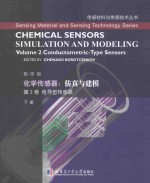图书介绍
化学传感器 仿真与建模 第2卷 电导型传感器 下 英文PDF|Epub|txt|kindle电子书版本网盘下载

- GhenadiiKorotcenkov主编 著
- 出版社: 哈尔滨:哈尔滨工业大学出版社
- ISBN:9787560349039
- 出版时间:2015
- 标注页数:486页
- 文件大小:2MB
- 文件页数:17页
- 主题词:化学传感器-研究-英文;电导-化学传感器-研究-英文
PDF下载
下载说明
化学传感器 仿真与建模 第2卷 电导型传感器 下 英文PDF格式电子书版下载
下载的文件为RAR压缩包。需要使用解压软件进行解压得到PDF格式图书。建议使用BT下载工具Free Download Manager进行下载,简称FDM(免费,没有广告,支持多平台)。本站资源全部打包为BT种子。所以需要使用专业的BT下载软件进行下载。如BitComet qBittorrent uTorrent等BT下载工具。迅雷目前由于本站不是热门资源。不推荐使用!后期资源热门了。安装了迅雷也可以迅雷进行下载!
(文件页数 要大于 标注页数,上中下等多册电子书除外)
注意:本站所有压缩包均有解压码: 点击下载压缩包解压工具
图书目录
7 EXPERIMENTAL INVESTIGATION AND MODELING OF GAS-SENSING EFFECT IN MIXED METAL OXIDE NANOCOMPOSITES&L.I.Trakhtenberg G.N.Gerasimov V.F.Gromov M.A.Kozhushner O.J.Лegbusi261
1 Introduction261
2 Types of Mixed Metal Oxides263
3 Synthesis of Metal Oxide Nanocomposites264
4 Charge Transfer Processes and Conductivity265
5 Conductivity Mechanism267
6 Sensor Properties269
7 Mechanism of Sensor Effect272
7.1 Sensors Based on Single Nanofibers272
7.2 Polycrystalline Sensors275
8 Modeling of the Sensory Effect for Reduced Gases283
8.1 Qualitative Discussion of the Sensory Mechanism283
8.2 Equilibrium Electronic Characteristics Of SnO2284
8.3 Sensor Response285
9 Conclusions290
Acknowledgment291
References291
8 THE INFLUENCE OF WATER VAPOR ON THE GAS-SENSING PHENOMENON OF TIN DIOXIDE-BASED GAS SENSORS&R.G.Pavelko297
1 Introduction297
2 Direct Water Effects on Tin Dioxide-Based Gas Sensors299
2.1 Undoped SnO2299
2.2 Doped SnO2307
3 Indirect Water Effects on Tin Dioxide--Based Gas Sensors310
3.1 Reducing Gases311
3.2 Oxidizing Gases322
4 Phenomenological Model323
5 Conclusions330
Acknowledgments330
References330
9 COMPUTATIONAL DESIGN OF CHEMICAL NANOSENSORS:TRANSITION METAL-DOPED SINGLE-WALLED CARBON NANOTUBES&Duncan J.Mowbray Juan Maria Garcia-Lastra Iker Larraza Arocena ?ngel Rubio Kristian S.Thygesen Karsten W.Jacobsen339
1 Introduction339
2 TM-Doped SWNTs as Nanosensors342
3 Density Functional Theory346
4 Kinetic Modeling351
5 Nonequilibrium Green's Function Methodology355
5.1 Divacancy Ⅱ358
5.2 Divacancy Ⅰ361
5.3 Monovacancy363
5.4 Target and Background Molecules364
6 Sensing Property369
7 Conclusions372
Acknowledgments373
References373
1O AL-DOPED GRAPHENE FOR ULTRASENSITIVE GAS DETECTION&Z.M.Ao Q.Jiang S.Li379
1 Emerging Graphene-Based Gas Sensors379
1.1 The Role of Aluminum Doping in Sensing Applications380
2 Aluminum-Doped Graphene for CO Detection381
2.1 Sensitivity Enhancement of CO Detection in Aluminum-Doped Graphene381
2.2 Effect of Electric Field on CO Detection387
2.3 Effect of Temperature on CO Detection393
3 Aluminum-Doped Graphene for Formaldehyde Detection399
3.1 Adsorption Enhancement with Aluminum Doping399
3.2 Variation of Electronic Properties Induced by Adsorption402
4 Aluminum-Doped Graphene for Detection of HF Molecules404
4.1 Adsorption Enhancement of Aluminum-Doped Graphene406
4.2 Adsorption Enhancement Mechanism410
4.3 Effect of Electric Field on Adsorption410
5 Conclusion and Future Challenges411
Acknowledgments413
References413
11 PHYSICS-BASED MODELING OF SNO2 GAS SENSORS WITH FIELD-EFFECT TRANSISTOR STRUCTURE&P.Andrei L.L.Fields A.J.Soares R.J.Perry Y.Cheng P.Xiong J.P.Zheng419
1 Introduction419
2 Physics-Based Modeling of the Nanobelts421
3 Model Calibration425
4 Analytical Model for Nanobelt Sensors430
4.1 Case 1:Nanobelt with Ohmic Contacts in the Presence of Hydrogen431
4.2 Case 2:Nanobelt with Ohmic Contacts in the Presence of Oxygen435
4.3 Case 3:Nanobelt with Schottky Contacts in the Presence of Oxygen439
5 Conclusion440
Appendix:Fabrication and Experimental Data441
References443
12 MODELING AND SIMULATION OF NANOWIRE-BASED FIELD-EFFECT BIOSENSORS&S.Baumgartner M.Vasicek C.Heitzinger447
1 Introduction447
2 Homogenization450
3 The Biofunctionalized Boundary Layer452
3.1 The Site-Dissociation Model453
3.2 Screening and Biomolecules454
3.3 Summary460
4 The Current Through the Nanowire Transducer461
4.1 The Drift-Diffusion-Poisson System461
4.2 Self-Consistent Simulations of Sensor Systems462
5 Summary464
Acknowledgment465
References465
INDEX471